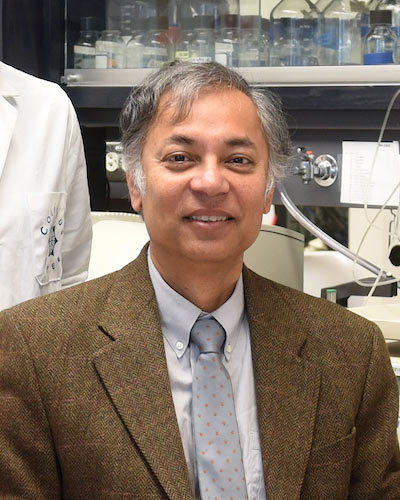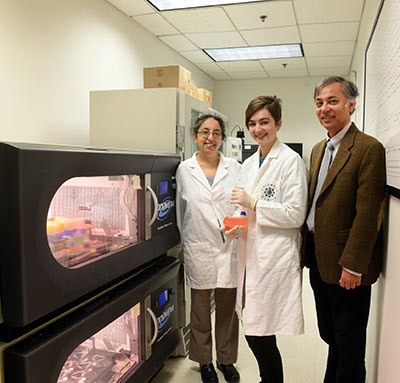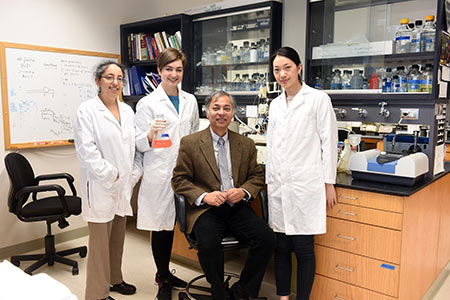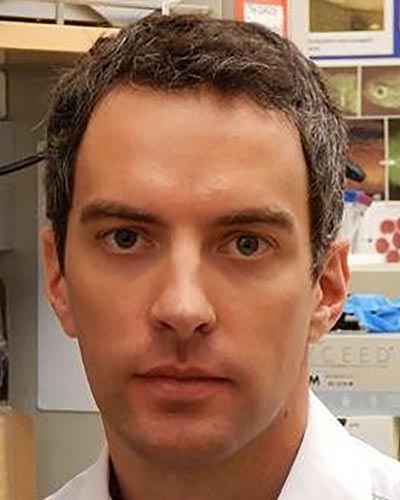December 19, 2017 | David Kohn

Discovery Helps Scientists Understand How Life May Survive on Other Planets
Three new studies by University of Maryland School of Medicine (UMSOM) scientists have identified key factors that help microbes survive in harsh environments.
The results, which have implications for biotechnology and understanding life in extreme conditions, were in the Proceedings of the National Academy of Sciences (PNAS), Astrobiology, and the International Journal of Astrobiology.
“These findings tell us a great deal about how these life forms are able to survive in these extreme environments,” said the principal author on the studies, Shiladitya DasSarma, PhD, a professor at the Institute of Marine and Environmental Technology in the UMSOM Department of Microbiology and Immunology. “We can take this new understanding and apply it in a variety of real-world contexts, including how life might thrive on other planets, and in green biotechnology here on Earth.”
The recent PNAS article builds on previous analysis by Prof. DasSarma and several colleagues, which identified key proteins in microbes found in extremely salty environments. They examined the amino acid composition of several of the microbe’s proteins. The protein surfaces are negatively supercharged compared to all other organisms. These proteins use the negative charges to tightly bind water molecules in order to stay in solution and combat the effects of high levels of salt and dryness. They focused on a microbe called H. lacusprofundi (Hla), from Deep Lake, a very salty lake in Antarctica.
 They wanted to find out how proteins from the microbe function in the dual extremes of very salty, very cold environments. They found that certain amino acids were more prevalent in the microbe. They focused on one enzyme, beta-galactosidase. They discovered key differences between versions of the enzyme in Hla and versions in microbes that live in temperate environments.. Among the key differences: looser packing of atoms and greater flexibility in cold-functioning enzymes.
They wanted to find out how proteins from the microbe function in the dual extremes of very salty, very cold environments. They found that certain amino acids were more prevalent in the microbe. They focused on one enzyme, beta-galactosidase. They discovered key differences between versions of the enzyme in Hla and versions in microbes that live in temperate environments.. Among the key differences: looser packing of atoms and greater flexibility in cold-functioning enzymes.
Another study, published in the journal Astrobiology, expands the study, by examining the role of enzymes in the microbe’s ability to survive in the presence of toxic salts. This research has implications for decontamination of toxic environments, as well as life on other planets such as Mars, where these toxic salts, particularly one called magnesium perchlorate, have been identified on the surface.
The third study, published last month in the International Journal of Astrobiology, showed that Hla and other similarly hardy microbes can survive trips into the stratosphere, many miles above the Earth’s surface, where conditions are similar to those on Mars. The stratosphere is extremely cold, has little oxygen and has high levels of damaging ultraviolet radiation.
These studies also have the potential to be useful for biotechnology. The approach in the PNAS study could be used for designing valuable enzymes that function at lower temperatures. For example, modified beta-galactosidase can be used for making lactose-free milk in cold temperatures, and other enzymes can be tailored for other “green” industrial processes at reduced temperatures, thereby reducing the amount of energy required in the manufacturing process. Perchlorate is used in rocket fuel and fireworks and is a common toxic contaminant in some ground water. The work in Astrobiology could lead to a method for its removal.
Co-authors on the papers include Victoria Laye, a PhD student in the MEES Graduate Program, and Priya DasSarma, M.S., laboratory research supervisor in the DasSarma laboratory at the Institute of Marine and Environmental Technology in the UMSOM Department of Microbiology and Immunology. The work was supported by NASA.
“Dr. DasSarma and his colleagues are analyzing key building blocks of life,” said E. Albert Reece, MD, PhD., MBA, Vice President for Medical Affairs at the University of Maryland and John Z. and Akiko K. Bowers Distinguished Professor and Dean of the University of Maryland School of Medicine. “Their research into the fundamentals of microbiology is enhancing our understanding of how life evolved in this planet, and how it might have evolved on others as well. Furthermore, this work has real-world potential in biotechnology and beyond.”
 About the University of Maryland School of Medicine
About the University of Maryland School of Medicine
Commemorating its 210th Anniversary, the University of Maryland School of Medicine was chartered in 1807 as the first public medical school in the United States. It continues today as one of the fastest growing, top-tier biomedical research enterprises in the world -- with 43 academic departments, centers, institutes, and programs; and a faculty of more than 3,000 physicians, scientists, and allied health professionals, including members of the National Academy of Sciences, and a distinguished recipient of the Albert E. Lasker Award in Medical Research. With an operating budget of more than $1 billion, the School of Medicine works closely in partnership with the University of Maryland Medical Center and Medical System to provide research-intensive, academic and clinically-based care for more than 1.2 million patients each year. The School has over 2,500 students, residents, and fellows, and nearly $450 million in extramural funding, with more than half of its academic departments ranked in the top 20 among all public medical schools in the nation in research funding. As one of the seven professional schools that make up the University of Maryland, Baltimore campus, the School of Medicine has a total workforce of nearly 7,000 individuals. The combined School and Medical System (“University of Maryland Medicine”) has a total budget of $5 billion and an economic impact of nearly $15 billion on the state and local community. The School of Medicine faculty, which ranks as the 8th-highest public medical school in research productivity, is an innovator in translational medicine with 600 active patents and 24 start-up companies. The School works locally, nationally, and globally, with research and treatment facilities in 36 countries around the world. Visit medschool.umaryland.edu/
About the College of Computer, Mathematical, and Natural Sciences
The College of Computer, Mathematical, and Natural Sciences at the University of Maryland educates more than 7,000 future scientific leaders in its undergraduate and graduate programs each year. The college's 10 departments and more than a dozen interdisciplinary research centers foster scientific discovery with annual sponsored research funding exceeding $150 million.
Articles:
- Victoria J. Laye, Ram Karan, Jong-Myoung Kim, Wolf T. Pecher, Priya DasSarma, and Shiladitya DasSarma.Key amino acid residues conferring enhanced enzyme activity at cold temperatures in an Antarctic polyextremophilic β-galactosidase. Proceedings of the National Academy of Sciences, U.S.A. 2017, 114 (47) 12530-12535; published ahead of print November 6, 2017, doi:10.1073/pnas.1711542114 http://www.pnas.org/content/114/47/12530.abstract
- P. DasSarma, V.J. Laye, J. Harvey, C. Reid, J. Shultz, A. Yarborough, A. Lamb, A. Koske-Phillips, A. Herbst, F. Molina, O. Grah, T. Phillips and S. DasSarma. Survival of halophilic Archaea in Earth's cold stratosphere. International Journal of Astrobiology. 2017, 16(4), 321-327. doi:10.1017/S1473550416000410 https://www.cambridge.org/core/journals/international-journal-of-astrobiology/article/div-classtitlesurvival-of-halophilic-archaea-in-earthandaposs-cold-stratospherediv/39ACDDEC70E2B4EA8F7FDC1BF576DC89
- Victoria J. Laye and Shiladitya DasSarma. An Antarctic Extreme Halophile and Its Polyextremophilic Enzyme: Effects of Perchlorate Salt. Astrobiology. 2018, 18(5), DOI: 10.1089/ast.2017.1766 http://online.liebertpub.com/doi/pdfplus/10.1089/ast.2017.1766
Learn More
Contact
Office of Public Affairs
655 West Baltimore Street
Bressler Research Building 14-002
Baltimore, Maryland 21201-1559
Contact Media Relations
(410) 706-5260
Related stories

Wednesday, July 19, 2023
New Innovation in CAR T-Cells Paves Way for Less Toxic Therapy Against Multiple Myeloma
University of Maryland School of Medicine (UMSOM) researchers engineered a new type of CAR T-cell therapy that, in preclinical studies, selectively attacked cancer cells while sparing healthy cells, potentially reducing the likelihood of toxic side effects from this innovative cancer treatment. The cells were designed specifically to attack multiple myeloma, a cancer of the plasma cells found in the body’s bone marrow.

Wednesday, April 05, 2023
Understanding E. Coli Strains That Do Not Cause Diarrhea Could Lead to New Treatments
News reports featuring E. coli often tell terrifying stories of intestinal illness and diarrhea or deadly outbreaks from contaminated food. There are, however, many different strains of the bacteria E. coli, or Escherichia coli, and not all are bad.

Friday, July 29, 2022
Why Breast-Fed Premature Infants Have A Healthier Gut Than Formula-Fed Ones
Human breastmilk has long been considered “liquid gold” among clinicians treating premature infants in a newborn intensive care unit (NICU). Breastmilk-fed “preemies” are healthier, on average, than those fed formula. Why is that true, however, has remained a mystery.

Monday, September 20, 2021
UM School of Medicine Receives $7.5 Million Grant to Create Complex Model of Female Reproductive Tract to Study Infections
Researchers at the Institute for Genome Sciences (IGS) at the University of Maryland School of Medicine have received a $7.5 million federal grant to create a complex model of the female reproductive system in order to study sexually transmitted infections (STIs). They plan to create a realistic 3D model that integrates vaginal and cervical epithelial cells and the bacteria that colonize these cells, called a microbiome. They aim to use this model to identity factors that play a role in chlamydia and gonorrhea infections experienced by a growing number of women in the U.S. and worldwide.

Friday, October 18, 2019
Diabetes Worsens Respiratory Illness Due to Abnormal Immune Response, UM School of Medicine Study Finds
Since the Middle East respiratory syndrome coronavirus (MERS-CoV) first emerged in Saudi Arabia in 2012, there have been more than 2,400 confirmed cases of the infection, resulting in greater than 800 deaths – an alarming fatality rate of 35 percent. For this reason, researchers have been eager to identify any risk factors that contribute to the development of severe or lethal disease. Current clinical evidence points to diabetes as a major risk factor in addition to other comorbidities including kidney disease, heart disease, and lung disease.

Tuesday, August 13, 2019
Researchers Identify How Vaginal Microbiome Can Elicit Resistance or Susceptibility to Chlamydia
The vaginal microbiome is believed to protect women against Chlamydia trachomatis, the etiological agent of the most prevalent sexually transmitted infections (STIs) in developed countries. New research by the University of Maryland School of Medicine (UMSOM) shows how the microbiome can either protect or make a woman more susceptible to these serious infections.

Friday, September 14, 2018
Nationwide Research on African-American Kidneys Hopes to Unravel Genetic Variation That Increases Disease Risk
With African-Americans developing kidney failure at rates four to five times higher than Americans of European descent, a groundbreaking nationwide study will track nearly every African-American donor kidney over the next five years.

Thursday, March 22, 2018
With Big Data, Researchers Identify New Targets for Lung Disease Treatments
Every year, approximately 12 million adults in the U.S. are diagnosed with Chronic Obstructive Pulmonary Disease (COPD), and 120,000 die from it. For people with COPD, Haemophilus influenzae, a bacterium, can be particularly dangerous.
